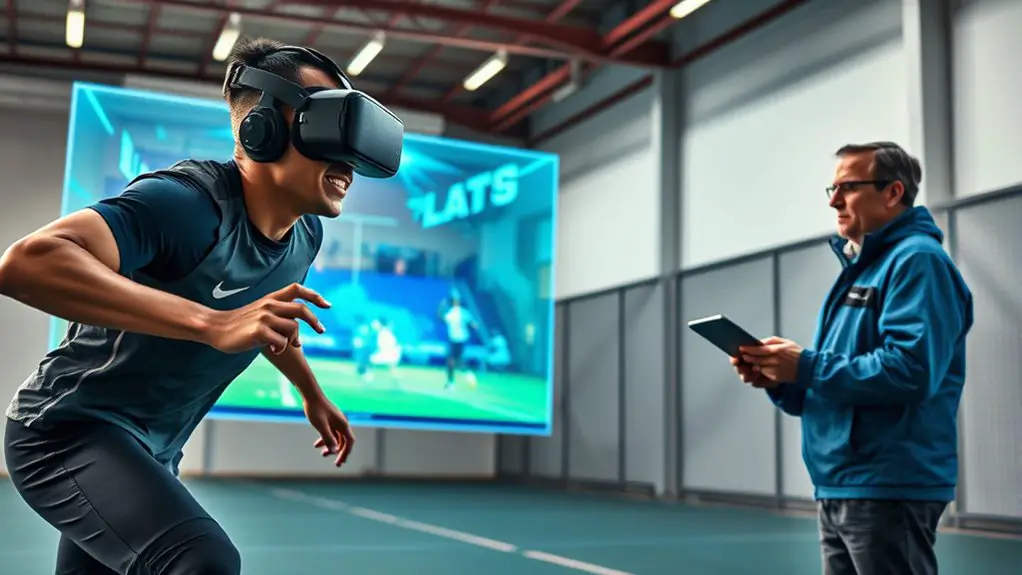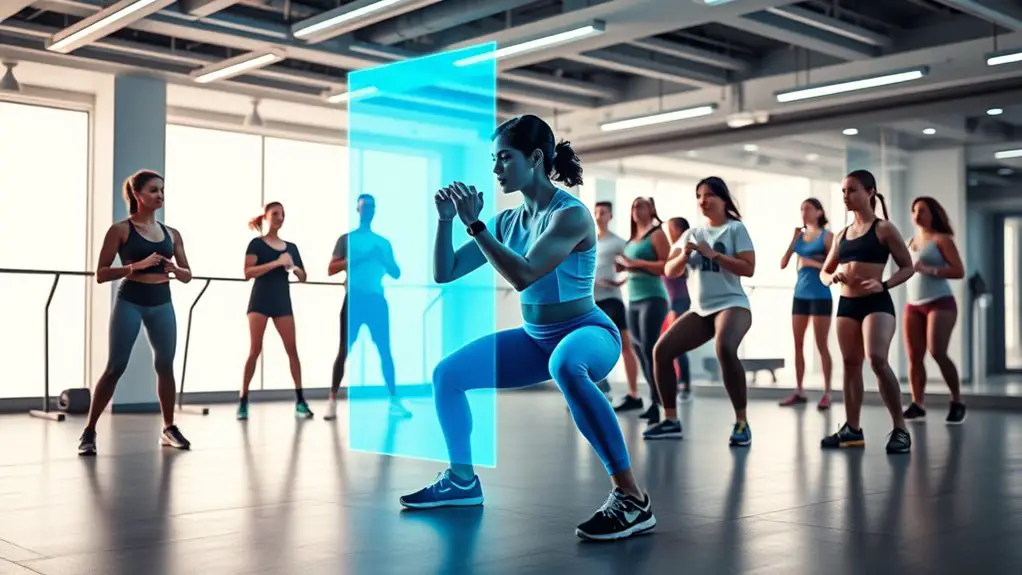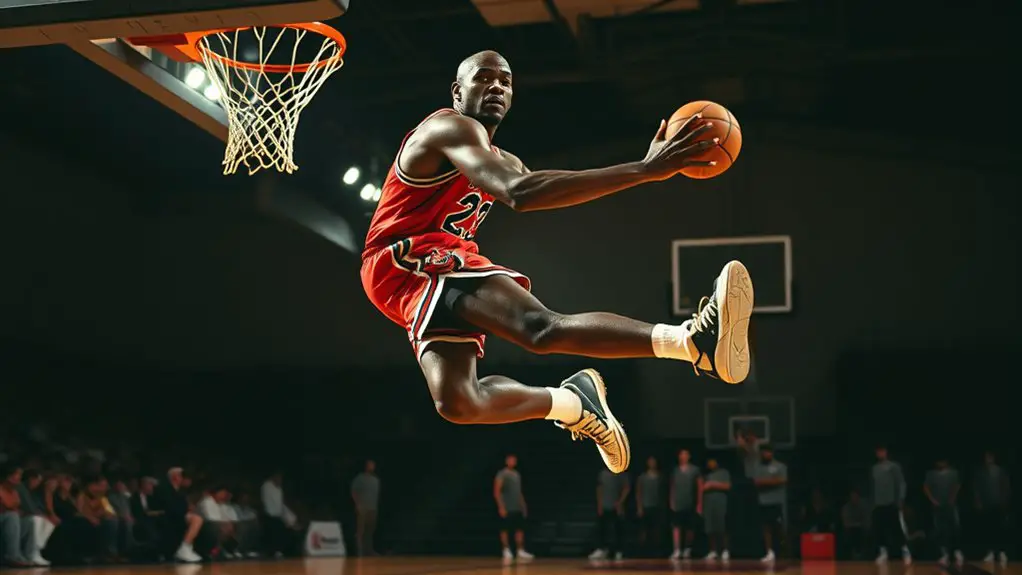Virtual reality is revolutionizing sports training by creating immersive simulations that enhance your performance and engagement. You can practice skills in lifelike situations, improve decision-making under pressure, and reduce injury risks through controlled environments. Personalized training programs adapt to your strengths and weaknesses, while coaches help integrate VR into your regimen. This innovative tech pushes the boundaries of athletic performance and builds mental toughness. Discover how it could transform your training experience further.
The Rise of Virtual Reality in Sports Training
As technology continues to evolve, more athletes are turning to virtual reality (VR) as a game-changing tool in their training regimens. You'll find that VR isn't just a trend; it's an emerging technology that fosters deeper athlete engagement. Imagine stepping into a virtual arena where you can practice your skills without the constraints of time or space. This freedom allows you to experiment and learn at your own pace, enhancing your overall performance.
With VR, you're not only simulating real-game scenarios but also gaining insights into your decision-making and strategies. You can visualize plays and refine techniques, giving you an edge over your competition. As athletes embrace these innovations, they're breaking free from traditional training limitations, revealing new levels of potential. The rise of VR in sports training is reshaping how you connect with your sport, empowering you to push boundaries and elevate your game like never before.
Enhancing Skill Development Through Immersive Simulations
In sports training, immersive simulations can put you right in the heat of realistic game scenarios. You'll find that these experiences allow for personalized training programs tailored to your specific needs. This approach not only sharpens your skills but also boosts your confidence on the field. Additionally, VR training can help you enhance mental agility by practicing decision-making skills in high-pressure situations.
Realistic Game Scenarios
While traditional training methods focus on repetitive drills, realistic game scenarios in virtual reality offer athletes a unique way to enhance their skills. With immersive simulations, you can experience game immersion like never before, sharpening your situational awareness in real-time situations. Imagine:
- Facing a rapid-fire opponent who challenges your reflexes.
- Navigating complex plays that mimic high-pressure game moments.
- Receiving instant feedback on your performance to adapt and grow.
- Visualizing strategic decisions that improve your overall gameplay.
These scenarios let you practice decision-making and reaction times in a safe environment, giving you the freedom to explore and refine your abilities. Embrace the future of training and take your skills to the next level!
Personalized Training Programs
By leveraging the power of virtual reality, trainers can create personalized training programs that cater specifically to individual athlete needs. This immersive technology allows you to gain adaptive feedback tailored to your performance metrics, enhancing your skill development like never before. Imagine training in your own virtual arena where every drill is customized just for you!
| Training Element | Adaptive Feedback | Performance Metrics |
|---|---|---|
| Skill Drills | Real-time adjustments | Accuracy and speed |
| Game Simulations | Scenario-based feedback | Decision-making efficiency |
| Recovery Sessions | Personalized pacing | Recovery time analysis |
| Strategy Sessions | Tactical feedback | Success rate assessment |
With these tailored experiences, you're not just training; you're evolving.
Analyzing Game Strategies With VR Technology
As athletes and coaches seek to gain a competitive edge, analyzing game strategies with VR technology has become an innovative approach. By immersing themselves in virtual environments, you can enhance your strategy visualization and refine your decision-making drills. Here are four powerful ways VR can transform how you analyze game strategies:
- Simulated Opponents: Face off against virtual competitors to practice your reactions in real-time.
- Tactical Review: Break down previous games by replaying scenarios and analyzing decisions.
- Situational Awareness: Experience game situations from different perspectives to better understand your role.
- Team Dynamics: Collaborate with teammates in a virtual setting, encouraging communication and cohesion.
With VR, you're not just watching the game; you're living it. This freedom to explore various strategies and scenarios can ultimately lead to more informed decisions on the field. Embrace this technology and elevate your game!
Reducing Injury Risks During Training Sessions
When you train with virtual reality, you can analyze your technique in a way that traditional methods just can't match. This technology creates controlled environments, allowing you to practice safely while minimizing injury risks. By focusing on these aspects, you can enhance your performance without the fear of physical setbacks. Additionally, incorporating proper warm-ups into your virtual training sessions can further reduce the risk of injuries like sprains and strains.
Enhanced Technique Analysis
While injuries are an ever-present risk in sports training, virtual reality (VR) offers a groundbreaking solution through enhanced technique analysis. By utilizing VR for technique refinement, you can greatly reduce the chances of injury. Here's how it works:
- Video Analysis: Capture your movements in real-time, allowing you to see what you can't feel.
- Feedback Loop: Receive instant feedback on your form and execution, helping you adjust on the fly.
- Safe Environment: Practice high-intensity maneuvers without the fear of real-world consequences.
- Personalized Training: Tailor sessions to address your specific weaknesses, ensuring you develop safely and effectively.
With VR, you can embrace your sport more freely, all while refining your skills and minimizing injury risks.
Controlled Training Environments
In a world where injuries can derail an athlete's progress, controlled training environments provided by virtual reality (VR) offer a safe haven for honing skills. You can push your limits without the fear of physical harm, as VR creates immersive virtual environments that simulate real-game scenarios. These training simulations allow you to practice techniques, refine your strategies, and build muscle memory—all while minimizing injury risks. Plus, you can experiment with different movements and tactics, giving you the freedom to explore your potential. With VR, you're not just training harder; you're training smarter. Embrace the power of technology to elevate your game while keeping your body safe and ready for the real challenges ahead.
Customizing Training Programs for Individual Athletes
Here's how VR customizes your training:
- Targeted Skill Drills: Focus on specific techniques you need to improve.
- Real-Time Feedback: Receive instant analysis of your performance, allowing for immediate adjustments.
- Scenario Simulation: Experience game-like situations that mimic real-world challenges.
- Progress Monitoring: Track your improvements over time to stay motivated and accountable.
With VR, you're not just another athlete in a group; you're crafting a training experience that resonates with your personal goals and aspirations. Embrace the freedom to train in ways that truly work for you, making each session a step toward greatness. Additionally, mindfulness in athletic performance can enhance your focus and engagement during these VR training sessions, further optimizing your development.
Improving Mental Toughness and Focus
As you immerse yourself in virtual reality training, one of the most significant benefits is the enhancement of your mental toughness and focus. VR scenarios can simulate high-pressure situations, pushing you to develop mental resilience while you engage in realistic practice. This technology helps you sharpen your focus, enabling you to block out distractions and hone in on your performance. Additionally, utilizing breathing exercises within VR can further calm your mind and enhance clarity during training sessions.
Here's a quick overview of how VR can enhance mental toughness and focus:
| Aspect | Impact |
|---|---|
| Mental Resilience | Builds your ability to cope with stress and setbacks. |
| Focus Enhancement | Trains your mind to concentrate amidst distractions. |
| Scenario Realism | Allows you to practice in lifelike conditions. |
| Instant Feedback | Provides immediate insights to improve your performance. |
Case Studies: Successful Implementations of VR in Various Sports
While many athletes are still discovering the benefits of virtual reality, several sports organizations have already embraced this technology to enhance training outcomes. Here are some inspiring case studies showcasing the impact of immersive experiences on athlete engagement:
Many athletes are discovering how virtual reality enhances training, with sports organizations already leveraging its benefits for performance improvement.
- NFL Teams: Players use VR simulations to practice plays, improving decision-making and situational awareness.
- NBA Programs: Basketball players experience game scenarios, honing their skills in a risk-free environment.
- Olympic Training: Athletes train for high-pressure moments by reliving past competitions, boosting confidence and focus.
- Soccer Clubs: Teams analyze opponents' strategies in a virtual setting, giving them a tactical edge on the field.
These implementations not only enhance skills but also foster a deeper connection to the sport. As you explore VR, imagine the freedom it brings to your training, pushing boundaries and revealing your full potential as an athlete.
The Role of Coaches in Integrating VR Into Training Regimens
Coaches play an essential role in successfully integrating VR into training regimens, ensuring that athletes maximize its potential. By embracing technology adoption, you create an environment that encourages innovation and exploration. It's about more than just using VR; it's about fostering coach collaboration with tech developers to tailor experiences that resonate with your team's unique needs.
You'll want to engage in open discussions with athletes about VR's benefits, helping them understand how it can enhance their skills and performance. Guiding them through the shift, you can address any concerns, making the process feel less intimidating.
Moreover, incorporating VR into practice can help simulate high-pressure situations, allowing athletes to build confidence and improve decision-making. Ultimately, by championing VR in training, you're not just enhancing performance; you're empowering athletes to take ownership of their development in a liberated, dynamic way.
The Future of Virtual Reality in Athletic Performance Training
Integrating VR into training regimens sets the stage for a groundbreaking evolution in athletic performance. As technology advancements continue, you'll witness exciting future trends revolutionizing how athletes train. Imagine stepping into a world where:
- Realistic simulations allow you to practice under pressure without the physical toll.
- Instant feedback helps you fine-tune your techniques in real-time, boosting your skills.
- Personalized training programs adapt to your unique strengths and weaknesses, optimizing your growth.
- Immersive environments transport you to stadiums or challenging terrains, enhancing your mental game.
With VR, you're not just training; you're liberating your potential. Embrace this technology, and let it elevate your performance, pushing the boundaries of what you thought was possible. The future's bright, and it's yours for the taking.
Frequently Asked Questions
What Are the Costs Associated With Implementing VR in Sports Training?
When considering the costs associated with implementing VR, you'll find that the initial investment can be significant. You'll need to budget for high-quality equipment and software, which can add up quickly. Then there's ongoing maintenance, which includes software updates and potential hardware repairs. While it may seem steep, the potential benefits could provide you with the freedom to enhance training effectiveness and athlete performance like never before.
Can VR Training Replace Traditional Training Methods Entirely?
You might wonder if VR training can replace traditional methods entirely. While virtual immersion offers enhanced cognitive engagement and unique experiences, it's unlikely to fully supplant traditional training. Each method has its strengths—VR can simulate scenarios and improve focus, but the tactile and social aspects of conventional training are hard to replicate. Instead, think of VR as a powerful supplement that can elevate your training without overshadowing proven techniques. Embrace the freedom to explore both worlds!
How Do Athletes Adapt to Using VR Technology?
When you immerse yourself in VR technology, you'll notice how athlete immersion plays an essential role in your adaptation. You'll find that the interactive environment enhances your focus and engagement, making training feel more dynamic. With performance analysis tools embedded in VR, you can receive immediate feedback on your skills, allowing you to adjust and improve faster. This freedom to explore new strategies can ultimately elevate your game and transform your training experience.
What Sports Benefit Most From VR Training?
When you think about sports that benefit most from VR training, basketball and football stand out. In basketball simulations, you can practice shooting, dribbling, and team plays without the pressure of a live game. For football, it's all about strategy; you can visualize plays, read defenses, and refine your decision-making skills in a safe environment. This freedom to experiment and learn in VR can really elevate your game and enhance your performance.
Are There Any Downsides to Using VR in Sports Training?
There are definitely some downsides to using VR in sports training. You might find that over-reliance on technology can lead to a lack of real-world skills. Plus, there's the risk of injury if you're not careful with your setup or usage. It's essential to balance virtual training with actual practice, ensuring you stay grounded and maintain your freedom of movement and adaptability in real athletic situations.




